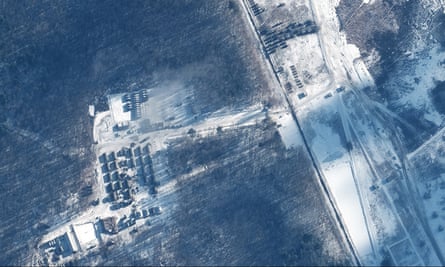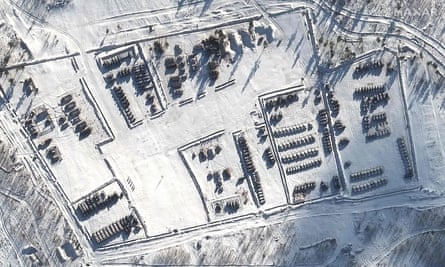Russia does not currently have enough troops on the border with Ukraine to carry out a full-scale military invasion and occupation of the country, according to western experts and senior officials in Kyiv.
They believe a Russian attack to capture most or all of Ukraine in the near future is unlikely, despite an unprecedented buildup of about 125,000 Russian soldiers, and military exercises due to take place next month in Belarus, within striking distance of the capital.
In an article published on Monday, Ukraine’s former defence minister Andriy Zagorodnyuk said the Kremlin has not yet amassed the several hundred thousand troops necessary for a large-scale operation, on the border and in Russian territory behind the frontline.
Several elements for an invasion were missing, he argued. These include completing the formation of battalion tactical groups including tank and airborne, setting up and testing a system of wartime administration, and deploying and staffing mobile hospitals.
“If Russia was conducting preparations for a large-scale invasion, it would have been much more noticeable,” Zagorodnyuk said, in a paper written with colleagues from his Kyiv thinktank, the Centre for Defence Strategies.
The analysis is supported by others. Konrad Muzyka, an open source intelligence specialist and president of Rochan Consulting, estimates that 66-67 Russian battalion tactical groups, the smallest operational unit in Moscow’s army, are in place near the border, including 11 battalions that have moved to Belarus.
Nevertheless, the US has suggested a full invasion would require at least 100 battalion, and western analysts familiar with the difficulties in holding Iraq have suggested twice that number or more would be needed to fight any counterinsurgency.
That larger force could be ready “if they maintain the current pace, in two to three weeks”, Muzyka said, particularly if airborne troops were brought up closer to the border. But Muzyka is sceptical that the battalions are full strength, with an average of 800 personnel. “Satellite imagery shows that there are too few tents,” he added.
If the Russian president, Vladimir Putin, wanted to target Kyiv with a lightning attack, the most direct route would be from Belarus, although any attack on the capital with more than 3 million people would risk large numbers of civilian casualties.

It would also be larger in scale than anything that Putin, or indeed Russia, has attempted since the second world war. Nick Reynolds, a land warfare analyst with the Rusi thinktank, believes it would stretch Russian logistics to their limit. “I question their ability to coordinate on this scale,” he said.
Supply is a particular issue, Reynolds added. “Russian units tend to hold a large stock of supplies and ammunition, using them until they run out. It makes them dangerous at first, but as they push deeper into hostile territory, their effectiveness drops quickly,” he said. Fresh units have to come forward and take over, because there is no immediate supply capability.
On the other hand, moving forces to Belarus, under the cover of the Allied Resolve joint exercises, also lengthens the territory Ukrainian forces have to defend and create openings for Russian tanks elsewhere. “They don’t have the manpower to cover it all,” Muzyka said.
“It isn’t difficult to get to Kyiv. The problem is to hold territory. To control it Russia will need a lot of troops,” said Gen Sergey Krivonos, the former deputy secretary in Ukraine’s national security and defence council.
He added: “Russian soldiers have been fed a lot of propaganda that doesn’t correspond to reality. They would quickly discover the population is deeply hostile. It’s an information failure.”

In the face of such obstacles, military and western sources believe the Kremlin is more likely to launch a more focused attack in the east and the Donbas region, where a war between the Ukrainian army and Moscow-armed separatists has gone on for nearly eight years, with 14,000 people killed.
This could be coupled with “hybrid” measures designed to demoralise the Ukrainian population such as cyber-shutdowns and attacks on critical infrastructure. The US has warned Russia is preparing a “false flag” operation inside separatist territory, which might be used as a pretext for war.
A British defence minister, James Heappey, said on Tuesday that the UK had intelligence to suggest efforts were being made to prepare the ground for a possible Russian attack. “We are becoming aware of a significant number of individuals that are assessed to be associated with Russian military advance-force operations and currently located in Ukraine,” he said.
The two sides face one another across a 155-mile (250km) “line of contact” around the rebel-held cities of Donetsk and Luhansk. Last week Ukrainian military intelligence agency said since the beginning of January Moscow has supplied the separatists with additional tanks, self-propelled artillery, mortars and more than 7,000 tons of fuel. Their numbers are roughly estimated at 34,000, but reliable figures are hard to come by.

The Kremlin has been actively recruiting mercenaries at centres inside the Russian Federation, the agency added. These unofficial soldiers go through “intensive training courses” before being smuggled across the Russian border to occupied Donetsk and Luhansk, it said.
Russia’s armed forces have been present covertly in separatist areas since 2014, according to the Ukrainian government. They could openly enter the conflict and then attempt to break through Ukrainian lines, amid a general intensification of hostilities.
Speaking privately, Ukrainian government insiders concede Moscow could easily target the port of Mariupol, which is 15 miles away from the frontline. The city is economically prosperous and home to a large metallurgical factory, the Illich iron and steelworks, named after Lenin.
Expanding territory controlled by the separatist Donetsk People’s Republic (DNR) would make the Russian-backed enclave more viable. Putin already effectively controls these areas and may take steps to recognise them legally or even annex them.
“It would be extremely hard for Russian troops to seize major Ukrainian cities such as Kyiv, Kharkiv or Odessa. There would be enormous resistance,” one former senior Ukrainian government official said. The person added: “A takeover of Mariupol would be easier. You could do it in two days and provoke a political crisis in Kyiv.”
A potential window for any offensive in the Donbas would be after 4 February, when Putin is due to attend the opening of the winter olympics in Beijing and to meet the Chinese president, Xi Jinping. The military exercises in Belarus are due to finish on 20 February, the most obvious moment for an offensive operation.
Any push to seize Mariupol could be carried out under a DNR flag, allowing the Kremlin deniability. It could claim fighting was part of a “civil war” in which it was not involved. However, it also has the option of encircling the port, by landing tanks and soldiers from the Sea of Azov.
Analysts agree that the situation is unpredictable, with many scenarios possible. But the consensus is Ukraine’s army consisting of 145,000 troops, according to the IISS thinktank, and 300,000 to 400,000 veterans with combat experience would offer significant resistance, even if outgunned by Russian forces with a superior air force and navy.
Along the existing frontline, Ukraine has deployed surface-to-air missile systems, officials are keen to stress, and a range of anti-tank weapons, including portable US Javelins, with a range of 1.6 miles, Ukrainian-made Stugna, and thousands of NLAW (next generation light anti-tank weapons), delivered to Kyiv last week by Boris Johnson’s government.
In the past week, Latvia and Lithuania, with the endorsement of the US, also dispatched Stinger anti-aircraft missiles. Germany, however, has so far declined to supply Ukraine with arms, holding up potential re-export of German-made artillery from the Baltic States.
Russia can deploy several thousand battle tanks and fighting vehicles, if its often cautious commanders are willing to tolerate losses in battle.
Yuriy Dumansky, the former deputy chief of Ukraine’s army staff, said soldiers were better prepared than in 2014, when they suffered humiliating military defeats, including in the eastern city of Ilovaisk. “They have learned how to fight. Psychologically they are much stronger,” he said.
Dumansky said the Kremlin’s recently deployment of troops to Kazakhstan showed its ability to react to political events quickly and decisively. But he said he was sceptical Russia had “sufficient” soldiers for a large-scale Ukraine invasion and said a “low intensity” conflict was more probable. “It was Machiavelli who pointed out it was easy to seize territory but much harder to hold it,” he said.